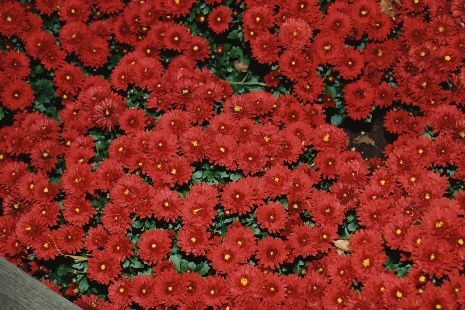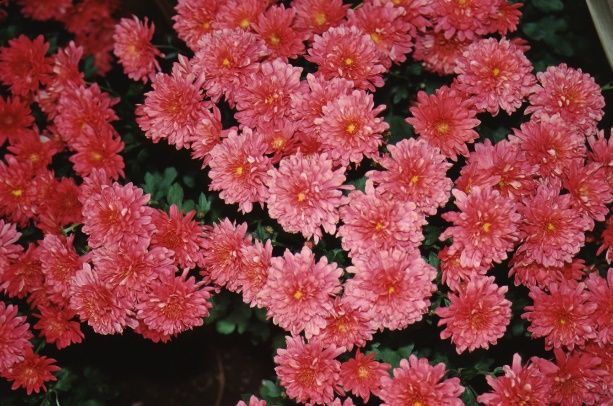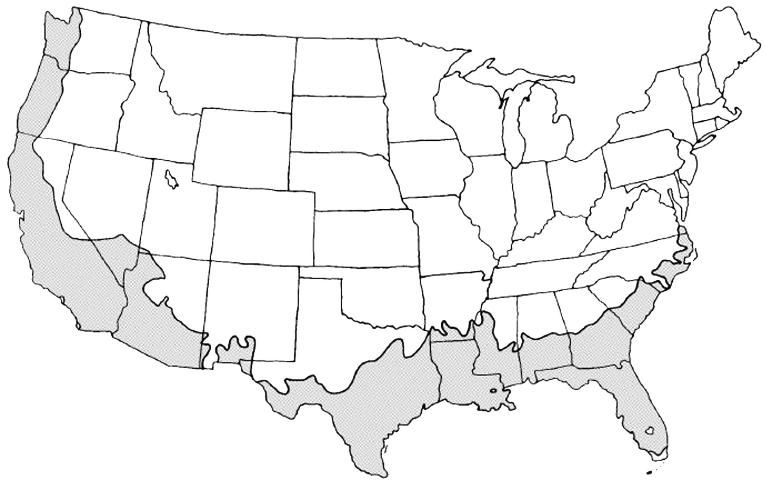Introduction
Dendranthema x grandiflora is a spreading perennial that reaches a height of about 6 inches. However, it may attain a height of 7 to 24 inches when in flower. Beautiful flower spikes appear in the fall and spring seasons. These flowers come in colors of brown, red, white, yellow, pink, or red-orange. The flowers may be cut for flower arrangements, and the plant is commonly massed in the landscape.

Credit: Edward F. Gilman, UF/IFAS

Credit: Edward F. Gilman, UF/IFAS
General Information
Scientific name: Dendranthema x grandiflora
Pronunciation: den-dran-THEEM-uh x gran-dif-FLOR-uh
Common name(s): garden mum, garden chrysanthemum, florists' chrysanthemum
Family: Compositae
Plant type: perennial; herbaceous
USDA hardiness zones: 8 through 10A (Figure 3)
Planting month for zone 7: Oct; Mar; Apr
Planting month for zone 8: Oct; Mar; Apr
Planting month for zone 9: not recommended
Planting month for zone 10 and 11: not recommended
Origin: not native to North America
Invasive potential: not known to be invasive
Uses: mass planting; edging; attracts butterflies
Availability: generally available in many areas within its hardiness range

Credit:
Description
Height: 1 to 2 feet
Spread: 1 to 2 feet
Plant habit: round
Plant density: dense
Growth rate: moderate
Texture: fine
Foliage
Leaf arrangement: alternate
Leaf type: simple
Leaf margin: lobed
Leaf shape: ovate
Leaf venation: pinnate
Leaf type and persistence: deciduous
Leaf blade length: 2 to 4 inches
Leaf color: green
Fall color: not applicable
Fall characteristic: not applicable
Flower
Flower color: pink; brown; red; white; yellow; red-orange
Flower characteristic: spring flowering; fall flowering
Fruit
Fruit shape: unknown
Fruit length: unknown
Fruit cover: unknown
Fruit color: unknown
Fruit characteristic: inconspicuous and not showy
Trunk and Branches
Trunk/bark/branches: typically multi-trunked or clumping stems
Current year stem/twig color: green
Current year stem/twig thickness: medium
Culture
Light requirement: plant grows in part shade/part sun
Soil tolerances: acidic; slightly alkaline; sand; loam; clay
Soil salt tolerances: unknown
Plant spacing: 18 to 24 inches
Other
Roots: not applicable
Winter interest: no special winter interest
Outstanding plant: plant has outstanding ornamental features and could be planted more
Pest resistance: very sensitive to one or more pests or diseases which can affect plant health or aesthetics
Use and Management
Garden mums will prosper in full sun to partial shade and prefer well-drained soils amended with organic matter. In sandy soils, a 3 to 4 inch layer of peat or compost should be worked into the top six inches of the soil. From late spring through mid-August, lightly prune stems without flower buds whenever they grow over six inches by snipping off the top 2 inches of growth. Prune off dead flower spikes.
Some varieties of garden mum produce tall flower spikes which must be staked. Chrysanthemum pacificum, a plant grown for its attractive, variegated foliage makes an interesting ground cover in full sun locations in central and north Florida.
Propagate Dendranthema x grandiflora by division or cuttings.
Pests and Diseases
The garden mum is relatively pest tolerant and has few pests of major concern. Leaf blight is probably the biggest concern.